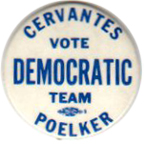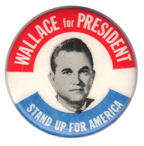Alfonso J. Cervantes served as the first big-city mayor of Hispanic origin in the U.S. He achieved the post in a city and state with relatively few Spanish-speaking voters.
Spanish speakers began to operate in what is now the state of Missouri during the 1700s and 1800s. In their search for wealth, Spanish explorers failed to find gold; instead they discovered lead and established a mining industry.
The Spanish outposts in Missouri were initially linked to a much larger settlement in New Orleans, which was sold to France before it and areas northward were turned over to the U.S. as part of the Louisiana Purchase.
Spain also sought, unsuccessfully, to use Missouri and other Midwestern areas as a buffer between the westward-expanding U.S. and Spain’s prized territories—administered from Sante Fe—in what is now the U.S. Southwest.
After Missouri became a state, employers recruited workers from Spain and Mexico to work in a variety of dirty and difficult jobs. These included the laying and maintaining of railroad track, working in zinc mines, and slaughtering cattle, as well as working in a number of factories making shoes and other products.
The WPA Guide to 1930s Missouri describes “some 3,000 Mexicans employed by the railroads and packing houses” as comprising “Kansas City’s second largest foreign group.” The Mexican colony lived close to these employers. The Guadalupe Fiesta, held in September, served as a major cultural event.
Hispanics were also attracted to the St. Louis area, including neighboring cities such as East St. Louis (Illinois), to work in mining.
Starting in 1935, the International Union of Mine, Mill and Smelter Workers began to organize zinc miners. The CIO union represented one avenue for political expression; running for office served as another way to influence public affairs.
Voters elected Alfonso J. Cervantes, then twenty-nine, to the St. Louis Board of Aldermen in 1949. This launched a career that would span four decades.
Cervantes was the first Hispanic to win local office. He enjoyed deeper ties to the area than many other, often immigrant, Spanish speakers. His grandfather was born in Louisiana in the mid-1880s. He subsequently moved to St. Louis, where he bore a son, August, who fathered Alfonso. The future politician attended St. Louis University and served in the Merchant Marine during World War II.
 Alfonso Cervantes won several reelections to the city council. In 1965, voters elected him mayor, a position he held until 1973. Cervantes addressed a number of difficult urban issues, including discrimination against and segregation of African Americans. As a result, St. Louis was one of the few large cities that did not experience rioting. After leaving office, he returned to the private sector, taught at St. Louis University, published a memoir, Mr. Mayor. The famous archway, for which he secured funding, is a physical reminder of the Cervantes administration.
Alfonso Cervantes won several reelections to the city council. In 1965, voters elected him mayor, a position he held until 1973. Cervantes addressed a number of difficult urban issues, including discrimination against and segregation of African Americans. As a result, St. Louis was one of the few large cities that did not experience rioting. After leaving office, he returned to the private sector, taught at St. Louis University, published a memoir, Mr. Mayor. The famous archway, for which he secured funding, is a physical reminder of the Cervantes administration.




